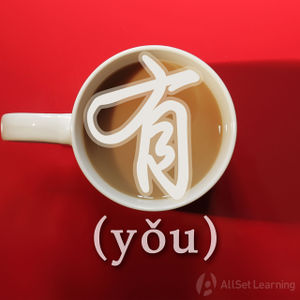Difference between revisions of "Expressing existence with "you""
m (Text replacement - "{{HSK|HSK1}}" to "{{HSK|HSK1}}{{2021-HSK|HSK1}}") |
|||
| (41 intermediate revisions by 13 users not shown) | |||
| Line 1: | Line 1: | ||
| − | {{Grammar Box}} | + | {{Grammar Box}} |
| − | 有 (yǒu) | + | The verb 有 (yǒu), which means "to have," can also be used to express existence. This is similar to saying "there is" or "there are" in English. |
== Structure == | == Structure == | ||
| − | + | Literally, this structure expresses that a place "has" a thing, which is to say, that thing is in the place. | |
<div class="jiegou"> | <div class="jiegou"> | ||
| − | Place + 有 + | + | Place + 有 + Obj. |
</div> | </div> | ||
| Line 17: | Line 17: | ||
<div class="liju"> | <div class="liju"> | ||
| − | * | + | *我 家 <em>有</em> 很 多 小 狗。<span class="pinyin">Wǒ jiā <em>yǒu</em> hěn duō xiǎo gǒu.</span><span class="trans">There are a lot of puppies in my home.</span> |
| − | * 日本 <em>有</em> 很 多 中国人。 <span class="trans">There are many Chinese people in Japan.</span> | + | *我们 学校 <em>有</em> 很 多 帅哥 。<span class="pinyin">Wǒmen xuéxiào <em>yǒu</em> hěn duō shuàigē.</span><span class="trans">There are a lot of cute guys in our school.</span> |
| − | * 这里 <em>有</em> | + | *日本 <em>有</em> 很 多 中国人。 <span class="pinyin">Rìběn <em>yǒu</em> hěn duō Zhōngguó rén.</span><span class="trans">There are many Chinese people in Japan.</span> |
| + | *这 个 酒吧 <em>有</em> 很 多 美女。<span class="pinyin">Zhège jiǔbā <em>yǒu</em> hěn duō měinǚ.</span><span class="trans">There are a lot of pretty girls in this bar.</span> | ||
| + | *你 家 <em>有</em> 牛奶 吗?<span class="pinyin">Nǐ jiā <em>yǒu</em> niúnǎi ma?</span><span class="trans">Is there milk in your house?</span> | ||
| + | *这里 <em>有</em> 一 个 问题。<span class="pinyin">Zhèlǐ <em>yǒu</em> yī gè wèntí.</span><span class="trans">There is a problem here.</span> | ||
| + | *房间 里 <em>有</em> 人 吗?<span class="pinyin">Fángjiān lǐ <em>yǒu</em> rén ma?</span><span class="trans">Is there anyone in the room?</span> | ||
| + | *杯子 里 <em>有</em> 水 吗?<span class="pinyin">Bēizi lǐ <em>yǒu</em> shuǐ ma?</span><span class="trans">Is there any water in the cup?</span> | ||
| + | *我 的 手机 里 <em>有</em> 你 的 号码。<span class="pinyin">Wǒ de shǒujī lǐ <em>yǒu</em> nǐ de hàomǎ.</span><span class="trans">Your number is in my cell phone.</span> | ||
| + | *现在 办公室 里 <em>有</em> 人 吗?<span class="pinyin">Xiànzài bàngōngshì lǐ <em>yǒu</em> rén ma?</span><span class="trans">Is there anyone in the office now?</span> | ||
</div> | </div> | ||
| Line 28: | Line 35: | ||
== Sources and further reading == | == Sources and further reading == | ||
| − | + | {{Source|HSK Standard Course 1|74}} | |
| − | + | {{Source|Chinese: An Essential Grammar, Second Edition|87-8}} | |
| − | + | {{Source|Integrated Chinese: Level 1, Part 1 (3rd ed)|53}} | |
| − | + | {{Source|New Practical Chinese Reader 1 (新实用汉语课本1)|105}} | |
| − | + | {{Source|New Practical Chinese Reader 1 (新实用汉语课本1)(2nd ed)|122-3}} | |
| − | + | {{Source|New Practical Chinese Reader 2 (新实用汉语课本2)|155}} | |
| − | + | {{Source|40 Lessons for Basic Chinese Course (基础汉语40课下册)|300-1}} | |
| + | {{Source|40 Lessons for Basic Chinese Course (基础汉语40课上册)|62, 73}} | ||
[[Category:A1 grammar points]] | [[Category:A1 grammar points]] | ||
| + | {{HSK|HSK1}}{{2021-HSK|HSK1}} | ||
{{Used for|Expressing existence}} | {{Used for|Expressing existence}} | ||
| − | {{Basic Grammar|有|A1|Place + | + | {{Used for|Indicating conditions}} |
| − | {{Similar|Negation of "you"}} | + | {{Used for|Describing places}} |
| + | {{Basic Grammar|有|A1|Place + 有 + Obj.|我们 学校 <em>有</em> 很 多 学生。|grammar point|ASG04ZCI}} | ||
| + | {{Similar|Negation of "you"}} | ||
| + | {{Similar|Expressing possession with "you"}} | ||
{{POS|Verbs}} | {{POS|Verbs}} | ||
{{Subprop|Verbs}} | {{Subprop|Verbs}} | ||
| + | {{Translation|is}} | ||
| + | {{Translation|have}} | ||
Latest revision as of 09:21, 20 April 2021
-
Level
-
Similar to
-
Used for
-
Keywords
The verb 有 (yǒu), which means "to have," can also be used to express existence. This is similar to saying "there is" or "there are" in English.
Structure
Literally, this structure expresses that a place "has" a thing, which is to say, that thing is in the place.
Place + 有 + Obj.
Examples
- 我 家 有 很 多 小 狗。There are a lot of puppies in my home.
- 我们 学校 有 很 多 帅哥 。There are a lot of cute guys in our school.
- 日本 有 很 多 中国人。 There are many Chinese people in Japan.
- 这 个 酒吧 有 很 多 美女。There are a lot of pretty girls in this bar.
- 你 家 有 牛奶 吗?Is there milk in your house?
- 这里 有 一 个 问题。There is a problem here.
- 房间 里 有 人 吗?Is there anyone in the room?
- 杯子 里 有 水 吗?Is there any water in the cup?
- 我 的 手机 里 有 你 的 号码。Your number is in my cell phone.
- 现在 办公室 里 有 人 吗?Is there anyone in the office now?
See also
Sources and further reading
- HSK Standard Course 1 (pp. 74) Anything Goes (无所不谈) →buy
- Chinese: An Essential Grammar, Second Edition (pp. 87-8) Anything Goes (无所不谈) →buy
- Integrated Chinese: Level 1, Part 1 (3rd ed) (pp. 53) Anything Goes (无所不谈) →buy
- New Practical Chinese Reader 1 (新实用汉语课本1) (pp. 105) Anything Goes (无所不谈) →buy
- New Practical Chinese Reader 1 (新实用汉语课本1)(2nd ed) (pp. 122-3) Anything Goes (无所不谈) →buy
- New Practical Chinese Reader 2 (新实用汉语课本2) (pp. 155) Anything Goes (无所不谈) →buy
- 40 Lessons for Basic Chinese Course (基础汉语40课下册) (pp. 300-1) [ →buy]
- 40 Lessons for Basic Chinese Course (基础汉语40课上册) (pp. 62, 73) [ →buy]



